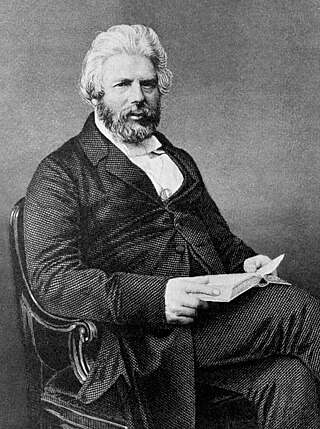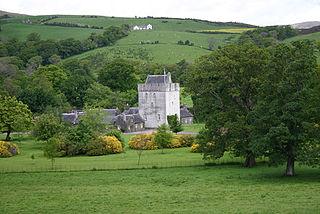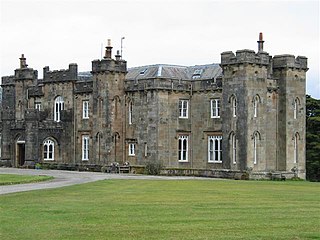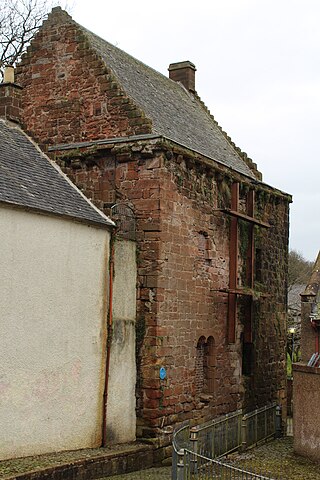Related Research Articles

Robert Chambers was a Scottish publisher, geologist, evolutionary thinker, author and journal editor who, like his elder brother and business partner William Chambers, was highly influential in mid-19th-century scientific and political circles.

John Knox House, popularly known as John Knox's House, is a historic house in Edinburgh, Scotland, reputed to have been owned and lived in by Protestant reformer John Knox during the 16th century. Although his name became associated with the house, he appears to have lived in Warriston Close where a plaque indicates the approximate site of his actual residence.

Dunure Castle is located on the west coast of Scotland, in South Ayrshire, about five miles south of Ayr and close to the village of Dunure. Today the castle stands in ruins on a rocky promontory on the Carrick coast, overlooking the small harbour of Dunure.

The Medea is a 1904 steam yacht preserved in the Maritime Museum of San Diego, United States. Named after Medea, the wife of Jason, she was built in a record 51 days on the Clyde at Alexander Stephen and Sons shipyard at Linthouse by John Stephen for William Macalister Hall of Torrisdale Castle, Scotland.

Glenluce is a small village in the parish of Old Luce in Wigtownshire, Scotland.

Kildonan Castle stands in the small village of Kildonan on the southern coast of the Isle of Arran in Scotland. The castle's name is derived from the name of a former resident, Saint Donan, who is said to be buried on the island.

Closeburn Castle is a privately owned tower house, probably of the 14th century, but possibly older, and is one of the oldest continually inhabited houses in Scotland. The castle is located 1 km east of the village of Closeburn, in the historical county of Dumfriesshire, 2 km south-east of Thornhill, in Dumfries and Galloway, Scotland.

Tillietudlem is a fictional castle in Walter Scott's 1816 novel Old Mortality, and a modern settlement in South Lanarkshire, Scotland.

Branxholme Castle is a five-storey tower at Branxholme, about 3 miles south-west of Hawick in the Borders region of Scotland.

Fatlips Castle is a peel tower in Roxburghshire, in the Scottish Borders. Situated at the top of Minto Crags, above the River Teviot, it was built in the 16th century by the Turnbulls of Barnhills, notorious Border reivers, and owners of nearby Barnhills Tower and farm. In 1545, during the War of the Rough Wooing, the Earl of Hertford burned "Mantoncrake", or Mynto Crag.

Chambers Street is a street in Edinburgh, Scotland, in the southern extremity of the Old Town. The street is named after William Chambers of Glenormiston, the Lord Provost of Edinburgh who was the main proponent of the Edinburgh Improvement Act (1867) which led to its creation in 1870. A narrow lane named North College Street and three residential squares built in the 18th century—Adam Square, Argyle Square and Brown Square—disappeared in the process. The street is dominated by University and museum buildings. It also hosts a variety of restaurants and venues.

Kames Castle is a 16th-century tower house located on the shore of Kames Bay near Port Bannatyne, on the Isle of Bute, Scotland. The castle, which is set in 20 acres (81,000 m2) of planted grounds, includes a 2-acre (8,100 m2) 18th-century walled garden. It is extended through the addition of a range of stone cottages. The castle, cottages, walled garden and other estate buildings are category B listed buildings.

Baron of Aiket (extinct) was a title of nobility in the Baronage of Scotland for the holder of the Barony of Aiket with its castle, lay within the old feudal bailiary of Cunninghame. The barony lands equate to the extant Parish of Dunlop, East Ayrshire, Scotland.

Torrisdale Castle is a historic mansion residence, overlooking Torrisdale Bay, Argyll, south of Carradale, Kintyre, Scotland. The castle is situated at the edge of the village of Torrisdale. It is a category B listed building.

Dippen Bay is an embayment along Kilbrannan Sound on the east coast of the Kintyre Peninsula in Scotland. Coastal erosion has been documented at Dippen Bay as well as nearby Torrisdale Bay. The bay is located along the coast near the hamlet of Dippen.

Dippen is a hamlet on the east coast of the Kintyre Peninsula in Scotland. The community of Dippen is in close proximity to Dippen Bay. Roads on the east coast of Kintyre were greatly improved in the era circa 1776, when the settlement was known as Duppin.

Torrisdale Bay is a coastal embayment along the east side of the Kintyre Peninsula within Kilbrannan Sound in Scotland. The shoreline of the bay consists partially of a shingle beach. Nearby is located Torrisdale Castle. The villages of Torrisdale and Bridgend lie along Torrisdale Bay with Carradale directly to the north. Bottlenose dolphins and harbor porpoises are often sighted.

Balcarres House lies 1km north of the village of Colinsburgh, in the East Neuk of Fife, in eastern Scotland. It is centred on a mansion built in 1595 by John Lindsay (1552–1598), second son of David, 9th Earl of Crawford. The house became the family seat of the Earl of Crawford. The present house is the result of substantial extensions in the early nineteenth century, using part of a fortune made in India, but preserves much of the original mansion.

Sundrum Castle is a Scottish medieval castle located 1.5 kilometres (0.93 mi) north of Coylton, South Ayrshire, by the Water of Coyle river. It was built in the 14th century for Sir Duncan Wallace, Sheriff of Ayr. The castle was inherited by Sir Alan de Cathcart, who was the son of Duncan's sister. The Cathcarts sold Sundrum in the 18th century, where it eventually fell into the possession of the Hamilton family. The Hamiltons expanded the castle in the 1790s, incorporating the original keep into a mansion.

Mauchline Castle, also known as Abbot Hunter's Tower, is a rectangular tower house dating from the fifteenth century, in Mauchline, East Ayrshire, Scotland. The tower once formed part of a group of monastic buildings associated with Melrose Abbey, and today is a category A listed building.
References
- Robert Chambers and William Chambers. 1844. The Gazetteer of Scotland